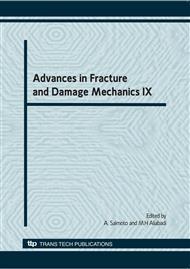p.665
p.669
p.673
p.677
p.681
p.685
p.689
p.693
p.697
Electrostatic Tractions at Crack Faces Taking into Account Full Piezoelectric Field Coupling
Abstract:
Cracks in piezoelectric solids have been subject to fracture mechanical investigations for more than 30 years. In the early years of research, boundary conditions at crack faces have been adopted from pure mechanical systems assuming traction free boundaries. From the electrostatic point of view, cracks have been assumed to be either free of surface charge or fully permeable. Later, limited permeable crack boundary conditions have become popular among the community, however still assuming traction-free crack faces. Recently, the theoretical framework has been extended including electrostatically induced mechanical tractions into crack models yielding a significant crack closure effect. However, these models are still simple neglecting e.g. piezoelectric field coupling. As one consequence, the tractions do not depend on the direction of the electric field with respect to the direction of material polarization. Here, an extended model is presented, entirely accounting for the piezoelectric coupling effect. In this case, the crack closure effect depends on the electric field direction. Additionally, the model yields a new shear effect.
Info:
Periodical:
Pages:
681-684
Citation:
Online since:
November 2010
Authors:
Price:
Сopyright:
© 2011 Trans Tech Publications Ltd. All Rights Reserved
Share:
Citation:


